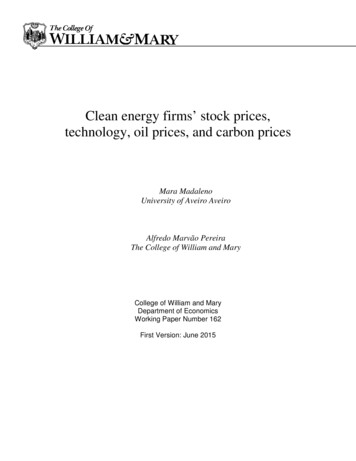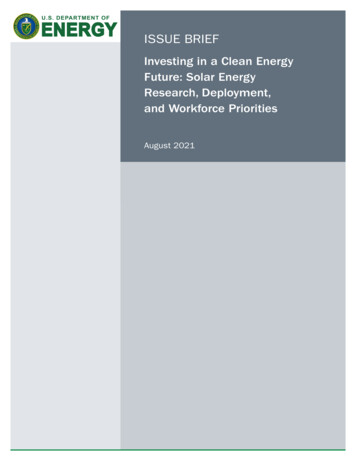
Transcription
Clean energy firms’ stock prices,technology, oil prices, and carbon pricesMara MadalenoUniversity of Aveiro AveiroAlfredo Marvão PereiraThe College of William and MaryCollege of William and MaryDepartment of EconomicsWorking Paper Number 162First Version: June 2015
.COLLEGEOF WILLIAM AND MARYDEPARTMENT OF ECONOMICSWORKING PAPER # 162June 2015Clean energy firms’ stock prices,technology, oil prices, and carbon priceAbstract: Production costs of alternative energies are still high, butincreased demand for oil, future oil supply shortage concerns and climatechange concerns, have led to the fast development of renewable energyfirms. The sector accomplished has accomplished remarkable progressand attracted attention to clean energy, both at the industry level and at theacademic side. With this work we attempt to determine whether or not theplacement of a price on carbon emissions encourages investments in cleanenergy firms. Unlike previous literature we focus on the German case andwe address the issue at the individual company level. We were able toverify this link but only for the case of companies whose weight over theamount of total energy produced is relevant, which is the case of solar inGermany.Keywords: Clean Energy; Firm Stock Prices; Oil Prices; Carbon Prices;Technology.Mara MadalenoDepartment of Economics, Management and Industrial Engineering, , DEGEI, GOVCOPP,University of Aveiro Aveiro, Portugal,maramadaleno@ua.ptAlfredo Marvão PereiraDepartment of Economics,The College of William and Mary, Williamsburg, USAPO Box 8795, Williamsburg, VA 23187ampere@wm.edu
Clean energy firms’ stock prices,technology, oil prices, and carbon pricesMara MadalenoAlfredo Marvão PereiraDepartment of Economics, Management and IndustrialEngineering, DEGEI, GOVCOPP, University of AveiroAveiro, Portugalmaramadaleno@ua.ptDepartment of EconomicsThe College of William and MaryWilliamsburg, Virginia, United Statesampere@wm.eduAbstract—Production costs of alternative energies are still high,but increased demand for oil, future oil supply shortageconcerns and climate change concerns, have led to the fastdevelopment of renewable energy firms. The sectoraccomplished has accomplished remarkable progress andattracted attention to clean energy, both at the industry leveland at the academic side. With this work we attempt todetermine whether or not the placement of a price on carbonemissions encourages investments in clean energy firms. Unlikeprevious literature we focus on the German case and we addressthe issue at the individual company level. We were able to verifythis link but only for the case of companies whose weight overthe amount of total energy produced is relevant, which is thecase of solar in Germany.Index Terms—Clean Energy; Firm Stock Prices; Oil Prices;Carbon Prices; Technology.I. INTRODUCTIONClimate change, resource scarcity of fossil fuels, energysecurity issues, and the development of new technologies havedriven the debate, attention and scientific explorationregarding clean energy. The quick increase in demand inemerging economies (mostly China and India) and future oilsupply shortages concerns (according to [1], world oilproduction is estimated to peak between 2016 and 2040) areexpected ultimately to lead to higher oil prices in the future.Energy security issues and increased concern over the naturalenvironment are also driving factors behind oil pricemovements. Moreover, the growing interest on renewableenergy may be related to the development of new technologiesand environmentally conscious consumers [2].All of these issues suggest that economies need to protectthemselves by substituting away from oil to alternative energysources. Accordingly, they have also caused a surge inalternate energy investments. Indeed, the renewable energysector has accomplished remarkable progress at the globallevel during the last decade. At the global level, it has beenestimated that private and public investment in renewableenergy climbed from 20 billion US in 2008 up to 150 billionin 2009. Nevertheless, the total investment in renewables isjust a very modest 0.26 percent of the global GDP. There is,therefore, huge room for expansion of the clean energysectors.The economics literature has followed these developments.In [3], the authors use a five-variable vector autoregressivemodel (VAR) using weekly data for stock prices of cleanenergy firms, technology stock prices, oil prices, carbonprices, and the interest rate. It argues that global climatechange drive the growth of alternative energy sources (lesscarbon intensive), inducing a positive relationship between theprice of carbon emission permits and the stock prices ofalternative energy sources. In [4] a Markov-Switching VAR isused relating oil prices, clean energy, technology stock pricesand interest rates. It finds a positive relationship between oilprices and clean energy prices after accounting for structuralchanges. It also argues in favor of the existence of a similarityin terms of market responses to both clean energy stock pricesand technology stock prices. In turn, [5] document the returnand volatility spillover effects between the stock prices ofChinese new energy and fossil fuel companies using theasymmetric BEKK model and daily data between 30 August2006 and 11 September 2012. Their empirical results showthat new energy and fossil fuel stocks are competing assets;that positive news about new energy stocks could affect theattractiveness of fossil fuel stocks and that new energy stockinvestment is more speculative and riskier than fossil fuelstock investment. In [6] a VAR is employed using daily datafrom 3 January 2001 until 30 May 2007 to study therelationship between clean energy stock prices and oil prices.The authors find that there is little impact of oil prices but asignificant impact from technology stock prices on stockprices of alternative energy companies. In [7] the contributionto this empirical analysis is pursued at the company levelconsidering a sample of 560 US companies divided into 14sectors. Using a GARCH model, it shows that differenteconomic sectors are affected in a different way by changes inoil prices. The transport and energy sectors are positivelyimpacted by oil price increases while the other sectors arenegatively impacted.
With this empirical evidence in mind, our main goal in thisnote is to explore how oil prices, carbon prices, technologystocks and individual stock returns are related to each other.The main goals of this work are: first, to explore at the firmlevel the links between clean energy stock prices, oil prices,carbon prices, and technology stock prices (as in [3], but at thecompany level and considering the fact that from 2014onwards oil prices faced a sharp drop); second, to account forthe relationships among the different variables at theindividual firm level, while endogenously controlling forstructural changes in the market such as the financial crisis,big oil price increases/decreases, and changes in the carbonallowances markets (in the spirit of [4]); third, to see if at theindividual stock company data the result of a significantrelationship between carbon prices and the stock prices of thefirms continues to fail to be identified (as in [3]); fourth, tounderstand how sensitive the financial performance ofalternative individual energy companies are to changes in oilprices, technology stock prices and carbon prices (in the spiritof [6]).Policymakers, with these results, would be able to judgewhich type of policies leverage significantly new energy stockinvestments and the extent to which the relevant financingchannel, for energy development; the energy related stockmarket is able to turn easier the economy transition to a greenmarket. Fossil fuel companies should be aware of thedownside risks for fossil fuel stock prices in the context ofcurrent energy policy. Opposite and favorable fossil fuelpolicies (mainly the upward adjustment of product oil prices)are not expected to stimulate new energy stock investments insome cases. As such, different energy policy combinationscould have different effects on the stability of energy stockinvestments and a higher effort should be placed to guaranteenew energy development.II. DATA AND METHODOLOGYA.DataIn this work, we use weekly data from the German stockmarket. We select to work with the German market becauserenewables contributing 23.9 per cent of gross electricityproduction in Germany in 2013. In 2012 Germany had onethird of the world's solar panels, and at one point these panelsgenerated a lot of Germany's electricity, thus justifying theinclusion of more solar energy companies into our sample. Infact, in [8] we can read “Comparing countries’ share ofrenewable energy in their energy supply, the map shows thatEuropean countries rank best in using low carbon resourcesfor their energy production. Germany’s “energy transition”could prove to be a role model for other countries to reducetheir fossil fuel consumption.” (p. 14). In this report USA andChina are marked as “poor” performers, despite their massiveinvestment in renewable energy in recent years. This furtherjustifies changing the market analysis focus to the Germancase away from focusing on these countries, as in the previousliterature.We collected daily data for the thirty one green companieslisted in the German market. Due to space limitations we haveselected ten of these to report here. These ten companies werechosen as representative of the different types of renewableenergy produced. Their names, activity, source, and start dateare described in Table 1.Table 1: Data SetCompanyVar. NameBIOGAS NORDr4CROPENERGIESr10HELIOCENTRIS EN.SLTN.r12NORDEXr15PETROTECr17S&O AGRARr20SOLONr27SUNLINEr29SUNWAYSr30VERBIO VER.BIOENERGIEr31All renewable energies index daxrdaxBD EU-MARK 3M DEPOSIT (FT/TR) - MIDDLE RATErirEEX-EU CO2 EMISSIONS E/EUA - spot marketreexco2Germany-DS Technology price index (TecDax)rtgrEurope Brent Spot Price FOB (Dollars per Barrel)reubtStart dateActivityWeekly observ.Source12/14/2006 Constructs biogas plants309deutsche-boerse.com10/2/2006 Produces biotethanol319deutsche-boerse.com6/26/2006 Fuel cell system platforms333deutsche-boerse.com8/5/2005 Wind energy379deutsche-boerse.com11/6/2006 Biodiesel producers from waste314deutsche-boerse.com8/5/2005 Biogas facilities379deutsche-boerse.com8/5/2005 Solar energy production379deutsche-boerse.com10/20/2005 Solar energy production369deutsche-boerse.com8/5/2005 Solar energy supply379deutsche-boerse.com10/16/2006 Biodiesel, bioethanol 379www.eia.govFor each of the remaining variables we consideredalternative possibilities. With respect to carbon prices, wehave data from the EEX-EU CO2 emissions E/EUA, theSettlement price CO2, Reuters CER 1-pos E/mt and the CO2,Reuters CER 2-pos E/mt EUR. With respect to technologyindices we have daily data from the Germany-DS technologyprice index and the PSE adjustment close price. Finally, oilprices series were collected with respect to: Cushing, OK WTISpot Price FOB (dollars per barrel) and Europe Brent SpotPrice FOB (dollars per barrel).All daily series were transformed into weekly observationsby using the value of every Wednesday in the spirit of [3]. Thedata period goes from: 05-08-2005 until 28-11-2012(changing with respect to start date depending on the series;see again Table 1). Furthermore, all price series have beentransformed into log-levels.B. MethodologyThe methodology used is a vector autoregressive analysis.We consider weekly five-variable VARs to study therelationship among the different variables for each of the 10clean energy companies stock prices as well as for the allrenewable energies index DAX for a total of 11 VAR models.The remaining variables are the same in all cases: the stockindex of technology companies in Germany, oil prices, carbonprices and the interest rate.We start by performing descriptive statistics andcorrelation matrices of the data used. Next we study unit rootproperties of the data and to the optimal number of lags to beused in the estimations. Afterwards we present the resultsobtained through VAR estimations, their impulse responsefunctions and variance decompositions.When the issue of orthogonalization was pertinent, wefollowed the assumptions in [3].The oil price was treated asthe most exogenous variable given that from the set it is themost independent one, once it mainly depends over OPEC’sdecisions regarding petroleum supply, although we may thinkof other factors able to affect it. After we have considered thecarbon price and companies/index returns. Climate change
concerns should induce the use of cleaner energies, whilehigher oil prices redirects users to other sources not alwaysless pollutant, which should impact CO2 allowances prices inthe market. Later these markets movements will be reflectedin individual alternate company’s returns. Furthermore, thetechnology index and the interest rate representative are leftfor last because we assume that only if alternate energyinvestments are made it is justified the jump over thetechnology index and this positive impact will also exertinfluence over the interest rate.Considering all of the alternative data series fortechnology, carbon price, oil price, and interest rates aspresented above, we find that our empirical results were notparticularly sensitive to the specific series we select to workwith for each variable. As such, we focus on the resultspertaining to the series identified in Table 1.III. EMPIRICAL RESULTS AND DISCUSSIONA. Granger CausalityIn Table 2, we show the Granger causality tests. Grangercausality tests indicate that the alternate DAX index isexplained by oil returns and technology stock prices. Inaddition, r10 is Granger caused by carbon allowance pricesand r12, r29 and r30 by high technology returns. So we cannotestablish a behavioral pattern with respect to company’sactivity. Moreover, while oil returns Granger-causes hightechnology returns, the reverse impact only occurs for therenewables index rDAX and in r20 and r29 companies.In all models we find that interest rates and the stockprices of clean energy companies are not related from aGranger causality perspective, contradicting [3] and [5],except for r15 and r17. There are only a few cases wherecarbon allowances Granger-cause oil prices, whereas oil priceshelp explain carbon allowances in all situations. In somesituations, similar to [3], with the exception of r10, r15, r17,r27, r31, we see that carbon prices do not Grange-cause thestock prices of clean energy firms and vice-versa. This resultmay be due to the spot price series used for carbon allowancesand not future prices. But it may also be due to the fact thatcarbon prices are too low to internalize the carbonexternalities. In sum, from a Granger causality perspective, oilprices are not the only variable able to explain the stock priceof alternative energy companies.Also, and unlike the literature, when we perform this typeof analysis with respect to individual clean energy firms, theinterest rate does not Granger-cause the stock price of hightechnology firms or even in the opposite direction, and theseresults prevail independently of the company considered. Thisresult may be justified by the low interest rates in recent yearsof our analysis and the low investment levels due to thefinancial crisis in Europe.Table 2: Granger Causality TestsDep. Excluded Chi-sq Prob. Dep. Excluded Chi-sq Prob. Dep. Excluded Chi-sq Prob. Dep. Excluded Chi-sq Prob. Dep. Excluded Chi-sq Prob. Dep. Excluded Chi-sq Prob.REUBT REEXCO2 5.333 0.255 REUBT REEXCO2 10.151 0.038 REUBT REEXCO2 10.691 0.030 REUBT REEXCO2 8.941 0.063 REUBT REEXCO2 10.227 0.037 REUBT REEXCO2 8.482 0.075RDAX 10.223 0.037R47.325 0.120R10 4.777 0.311R12 6.738 0.150R15 3.873 0.423R17 0.482 0.975RTGR 17.384 0.002RTGR 6.818 0.146RTGR 7.560 0.109RTGR 6.144 0.189RTGR 5.344 0.254RTGR 8.809 0.066RIR1.043 0.903RIR0.399 0.983RIR0.373 0.985RIR0.531 0.970RIR4.464 0.347RIR 0.420 0.981All 34.274 0.005All 25.905 0.055All 22.286 0.134All 23.714 0.096All 24.583 0.078All 17.465 0.356REEXCO2 REUBT 35.721 0.000 REEXCO2 REUBT 35.989 0.000 REEXCO2 REUBT 36.349 0.000 REEXCO2 REUBT 31.831 0.000 REEXCO2 REUBT 42.350 0.000 REEXCO2 REUBT 35.708 0.000RDAX 8.439 0.077R41.894 0.755R10 7.647 0.105R12 9.451 0.051R15 9.507 0.050R17 1.264 0.867RTGR 1.011 0.908RTGR 1.939 0.747RTGR 1.717 0.788RTGR 1.016 0.907RTGR 4.553 0.336RTGR 2.752 0.600RIR1.750 0.782RIR1.988 0.738RIR2.021 0.732RIR2.652 0.618RIR0.973 0.914RIR 2.297 0.681All 51.134 0.000All 45.859 0.000All 53.213 0.000All 56.601 0.000All 55.887 0.000All 45.316 0.000RDAX REUBT 13.966 0.007 R4 REUBT 4.006 0.405 R10 REUBT 6.124 0.190 R12 REUBT 4.981 0.289 R15 REUBT 5.351 0.253 R17 REUBT 1.768 0.778REEXCO2 2.317 0.678REEXCO2 6.137 0.189REEXCO2 8.692 0.069REEXCO2 1.680 0.794REEXCO2 4.312 0.366REEXCO2 5.159 0.271RTGR 24.836 0.000RTGR 4.665 0.324RTGR 2.224 0.695RTGR 10.368 0.035RTGR 5.784 0.216RTGR 4.749 0.314RIR1.287 0.864RIR0.972 0.914RIR0.523 0.971RIR2.473 0.650RIR5.366 0.252RIR 5.186 0.269All 56.037 0.000All 16.046 0.450All 18.257 0.309All 21.058 0.176All 19.629 0.237All 15.233 0.508RTGR REUBT 11.015 0.026 RTGR REUBT 8.982 0.062 RTGR REUBT 7.556 0.109 RTGR REUBT 7.553 0.109 RTGR REUBT 7.347 0.119 RTGR REUBT 8.605 0.072REEXCO2 6.741 0.150REEXCO2 7.684 0.104REEXCO2 6.664 0.155REEXCO2 6.038 0.196REEXCO2 9.527 0.049REEXCO2 7.143 0.129RDAX 2.818 0.589R4 17.026 0.002R10 13.168 0.011R12 5.313 0.257R15 10.462 0.033R17 2.158 0.707RIR3.666 0.453RIR3.062 0.547RIR3.468 0.483RIR3.379 0.497RIR3.010 0.556RIR 3.412 0.492All 24.541 0.078All 38.411 0.001All 34.194 0.005All 25.333 0.064All 30.999 0.014All 22.341 0.133RIR REUBT 1.792 0.774 RIR REUBT 2.185 0.702 RIR REUBT 1.920 0.750 RIR REUBT 1.632 0.803 RIR REUBT 6.236 0.182 RIR REUBT 1.717 0.788REEXCO2 1.303 0.861REEXCO2 2.989 0.560REEXCO2 4.192 0.381REEXCO2 2.760 0.599REEXCO2 0.411 0.982REEXCO2 4.116 0.391RDAX 3.900 0.420R42.158 0.707R10 1.240 0.871R12 3.842 0.428R15 8.848 0.065R17 16.231 0.003RTGR 2.061 0.725RTGR 3.585 0.465RTGR 1.455 0.835RTGR 1.591 0.810RTGR 2.107 0.716RTGR 1.688 0.793All9.701 0.882All9.916 0.871All9.227 0.904All 11.943 0.748All 19.082 0.265All 24.476 0.080Dep. Excluded Chi-sq Prob. Dep. Excluded Chi-sq Prob. Dep. Excluded Chi-sq Prob. Dep. Excluded Chi-sq Prob. Dep. Excluded Chi-sq Prob.REUBT REEXCO2 8.612 0.072 REUBT REEXCO2 4.316 0.116 REUBT REEXCO2 9.399 0.052 REUBT REEXCO2 9.553 0.049 REUBT REEXCO2 9.169 0.057R204.869 0.301R272.024 0.364R291.737 0.784R302.247 0.691R313.050 0.549RTGR 9.278 0.055RTGR 3.320 0.190RTGR 8.894 0.064RTGR 6.958 0.138RTGR 9.256 0.055RIR4.034 0.402RIR0.996 0.608RIR3.907 0.419RIR4.217 0.377RIR0.395 0.983All25.637 0.059All11.878 0.157All22.636 0.124All22.862 0.118All20.435 0.201REEXCO2 REUBT 38.571 0.000 REEXCO2 REUBT 23.883 0.000 REEXCO2 REUBT 38.398 0.000 REEXCO2 REUBT 41.104 0.000 REEXCO2 REUBT 35.519 0.000R200.166 0.997R275.577 0.062R291.022 0.906R306.044 0.196R31 10.660 0.031RTGR 3.243 0.518RTGR 0.772 0.680RTGR 2.726 0.605RTGR 2.788 0.594RTGR 2.570 0.632RIR0.839 0.933RIR0.104 0.949RIR0.856 0.931RIR0.968 0.915RIR2.156 0.707All45.353 0.000All31.060 0.000All45.698 0.000All51.981 0.000All56.386 0.000R20 REUBT 1.988 0.738 R27 REUBT 4.278 0.118 R29 REUBT 3.172 0.530 R30 REUBT 6.439 0.169 R31 REUBT 1.897 0.755REEXCO2 0.058 1.000REEXCO2 0.442 0.802REEXCO2 0.335 0.987REEXCO2 3.151 0.533REEXCO2 6.921 0.140RTGR 2.614 0.624RTGR 2.104 0.349RTGR 11.105 0.025RTGR 8.783 0.067RTGR 6.992 0.136RIR2.579 0.631RIR0.470 0.791RIR0.986 0.912RIR1.022 0.906RIR5.677 0.225All6.436 0.983All7.854 0.448All14.423 0.567All16.599 0.412All19.333 0.252RTGR REUBT 8.697 0.069 RTGR REUBT 5.970 0.051 RTGR REUBT 8.653 0.070 RTGR REUBT 6.135 0.189 RTGR REUBT 9.774 0.044REEXCO2 8.111 0.088REEXCO2 3.426 0.180REEXCO2 8.255 0.083REEXCO2 10.246 0.037REEXCO2 7.966 0.093R202.554 0.635R274.808 0.090R294.209 0.379R30 13.106 0.011R31 18.112 0.001RIR1.759 0.780RIR0.468 0.791RIR1.805 0.772RIR2.033 0.730RIR3.788 0.435All22.646 0.124All17.223 0.028All24.046 0.089All33.793 0.006All39.649 0.001RIR REUBT 5.367 0.252 RIR REUBT 3.653 0.161 RIR REUBT 5.407 0.248 RIR REUBT 4.684 0.321 RIR REUBT 2.035 0.729REEXCO2 0.429 0.980REEXCO2 0.194 0.907REEXCO2 0.498 0.974REEXCO2 0.414 0.981REEXCO2 3.795 0.435R200.761 0.944R271.822 0.402R294.660 0.324R307.421 0.115R311.988 0.738RTGR 3.692 0.449RTGR 0.621 0.733RTGR 5.032 0.284RTGR 4.731 0.316RTGR 2.955 0.565All10.767 0.824All7.701 0.463All14.582 0.555All17.615 0.347All9.962 0.869B. Variance DecompositionIn Table 3 we have the results obtained for the variancedecomposition considering horizons up to ten weeks. Withrespect to the all renewables DAX index, the variable whichmost contributes to the explanation of the variance of theerror produced in the prediction of oil is technology, beingfollowed by the index, while it is oil that most explanatorycapacity has over carbon allowances followed by the DAX.There is an even higher influence of the technology index interms of the explanatory capacity of the variance of the errorproduced in the prediction over the all renewables index,followed by oil, but it is oil that most influences technology.In terms of the interest rate, the impact of the other variablesis almost marginal, thus reinforcing the previous results.
Table 3: Variance DecompositionCholesky Ordering: REUBT REEXCO2 RDAX RTGR RIRVariance Decomposition of REUBT:Period REUBT REEXCO2 RDAX RTGR RIR1 100.000 0.000 0.000 0.000 0.0002 93.909 0.020 1.413 4.615 0.0423 93.737 0.023 1.472 4.581 0.1884 92.689 0.096 1.451 5.577 0.1875 87.526 1.959 3.777 5.611 1.1266 87.443 2.004 3.772 5.634 1.1467 87.102 1.999 3.787 5.831 1.2818 86.936 2.065 3.789 5.821 1.3899 86.943 2.066 3.781 5.811 1.39910 86.934 2.070 3.781 5.816 1.399Variance Decomposition of REEXCO2:Period REUBT REEXCO2 RDAX RTGR RIR1 0.516 99.484 0.000 0.000 0.0002 1.262 98.335 0.031 0.001 0.3713 7.033 91.947 0.654 0.001 0.3654 6.966 88.327 2.974 0.985 0.7485 12.207 82.695 3.417 0.925 0.7556 12.178 82.223 3.641 1.129 0.8287 12.252 81.964 3.730 1.127 0.9288 12.278 81.882 3.728 1.147 0.9659 12.225 81.753 3.853 1.197 0.97110 12.210 81.624 3.847 1.196 1.123Variance Decomposition of RDAX:Period REUBT REEXCO2 RDAX RTGR RIR1 0.003 1.558 98.438 0.000 0.0002 4.549 1.380 88.731 5.279 0.0603 4.667 1.829 85.897 7.479 0.1284 5.668 1.773 82.247 9.965 0.3485 7.461 2.181 79.990 9.951 0.4166 7.394 2.162 79.293 9.872 1.2787 7.405 2.163 79.239 9.899 1.2948 7.395 2.160 79.108 10.024 1.3139 7.385 2.216 79.050 10.016 1.33310 7.372 2.213 78.906 10.025 1.485Variance Decomposition of RTGR:Period REUBT REEXCO2 RDAX RTGR RIR1 5.518 0.034 2.269 92.179 0.0002 9.076 0.553 2.554 87.804 0.0143 9.725 1.548 2.563 86.106 0.0584 9.514 2.432 2.551 84.229 1.2735 9.645 2.499 2.559 83.854 1.4436 9.656 2.563 2.732 83.605 1.4447 9.684 2.565 2.736 83.390 1.6258 9.702 2.589 2.730 83.257 1.7229 9.726 2.587 2.733 83.227 1.72610 9.723 2.589 2.732 83.184 1.773Variance Decomposition of RIR:Period REUBT REEXCO2 RDAX RTGR RIR1 0.452 0.345 0.079 0.070 99.0532 0.582 0.273 0.539 0.298 98.3083 1.256 0.286 0.493 0.278 97.6864 1.656 0.303 0.488 0.502 97.0515 1.719 0.300 0.484 0.948 96.5496 1.619 0.282 0.573 0.955 96.5717 1.623 0.266 0.537 0.884 96.6908 1.770 0.267 0.534 0.879 96.5509 1.834 0.267 0.547 0.919 96.43310 1.836 0.271 0.551 0.964 96.378Cholesky Ordering: REUBT REEXCO2 R4 RTGR RIR Cholesky Ordering: REUBT REEXCO2 R10 RTGR RIRVariance Decomposition of REUBT:Variance Decomposition of REUBT:Period REUBT REEXCO2 R4 RTGR RIR Period REUBT REEXCO2 R10 RTGR RIR1 100.000 0.000 0.000 0.000 0.000 1 100.000 0.000 0.000 0.000 0.0002 96.393 0.298 2.154 1.150 0.005 2 97.008 0.344 0.961 1.680 0.0073 95.123 0.314 3.428 1.130 0.005 3 96.394 0.344 1.572 1.664 0.0274 94.637 0.365 3.397 1.578 0.023 4 95.870 0.379 1.595 2.125 0.0315 92.727 1.945 3.401 1.558 0.369 5 93.907 1.759 1.884 2.080 0.3706 92.573 2.080 3.395 1.555 0.397 6 93.832 1.771 1.883 2.093 0.4207 92.505 2.119 3.396 1.575 0.406 7 93.719 1.770 1.965 2.093 0.4538 92.407 2.146 3.420 1.613 0.414 8 93.577 1.791 2.049 2.121 0.4619 92.374 2.148 3.417 1.632 0.429 9 93.515 1.789 2.098 2.131 0.46710 92.357 2.148 3.422 1.631 0.442 10 93.483 1.788 2.112 2.130 0.486Variance Decomposition of REEXCO2:Variance Decomposition of REEXCO2:Period REUBT REEXCO2 R4 RTGR RIR Period REUBT REEXCO2 R10 RTGR RIR1 0.950 99.050 0.000 0.000 0.000 1 0.730 99.270 0.000 0.000 0.0002 1.539 97.973 0.155 0.001 0.332 2 1.224 98.391 0.101 0.012 0.2723 6.703 92.634 0.323 0.017 0.322 3 6.441 93.190 0.095 0.014 0.2614 6.626 90.742 0.997 1.002 0.633 4 6.307 90.116 2.526 0.437 0.6155 10.351 86.759 1.153 1.094 0.644 5 10.123 85.267 3.327 0.678 0.6056 10.345 86.689 1.210 1.102 0.654 6 10.123 85.219 3.359 0.678 0.6207 10.321 86.437 1.336 1.134 0.772 7 10.104 85.053 3.469 0.714 0.6598 10.325 86.332 1.379 1.148 0.816 8 10.124 84.981 3.494 0.720 0.6819 10.324 86.316 1.382 1.155 0.822 9 10.145 84.902 3.541 0.722 0.69010 10.320 86.289 1.382 1.155 0.853 10 10.145 84.873 3.540 0.722 0.720Variance Decomposition of R4:Variance Decomposition of R10:Period REUBT REEXCO2 R4 RTGR RIR Period REUBT REEXCO2 R10 RTGR RIR1 0.921 0.202 98.877 0.000 0.000 1 1.106 1.013 97.881 0.000 0.0002 1.006 0.231 98.159 0.543 0.061 2 1.148 1.316 97.392 0.122 0.0223 1.123 0.287 97.125 1.386 0.079 3 3.399 3.447 92.666 0.459 0.0294 1.450 1.454 95.567 1.403 0.126 4 3.470 3.808 92.156 0.465 0.1015 2.157 2.153 93.930 1.395 0.364 5 3.466 3.976 91.896 0.470 0.1936 2.157 2.161 93.781 1.508 0.393 6 3.490 4.032 91.812 0.474 0.1927 2.156 2.162 93.702 1.517 0.464 7 3.608 4.065 91.635 0.473 0.2198 2.158 2.167 93.669 1.528 0.478 8 3.640 4.063 91.578 0.493 0.2269 2.188 2.189 93.592 1.527 0.503 9 3.645 4.063 91.567 0.494 0.23110 2.188 2.190 93.586 1.530 0.506 10 3.645 4.063 91.553 0.494 0.245Variance Decomposition of RTGR:Variance Decomposition of RTGR:Period REUBT REEXCO2 R4 RTGR RIR Period REUBT REEXCO2 R10 RTGR RIR1 3.718 0.000 6.310 89.972 0.000 1 4.032 0.125 7.261 88.582 0.0002 6.116 0.099 10.751 83.033 0.000 2 6.103 0.371 9.565 83.951 0.0103 6.263 0.862 10.643 82.222 0.010 3 6.252 1.037 9.836 82.862 0.0134 6.123 1.988 10.404 80.627 0.858 4 6.040 2.393 9.983 80.688 0.8965 6.279 2.060 11.327 79.411 0.924 5 6.365 2.473 9.886 80.355 0.9206 6.370 2.072 11.326 79.307 0.926 6 6.365 2.474 9.907 80.329 0.9267 6.432 2.075 11.341 79.136 1.017 7 6.392 2.477 9.963 80.189 0.9808 6.436 2.080 11.351 79.064 1.069 8 6.451 2.477 9.947 80.100 1.0249 6.438 2.103 11.347 79.036 1.077 9 6.450 2.480 9.966 80.073 1.03210 6.442 2.102 11.341 78.999 1.116 10 6.449 2.480 9.965 80.056 1.049Variance Decomposition of RIR:Variance Decomposition of RIR:Period REUBT REEXCO2 R4 RTGR RIR Period REUBT REEXCO2 R10 RTGR RIR1 0.305 0.414 0.383 0.076 98.822 1 0.495 0.445 0.011 0.075 98.9742 0.320 0.374 0.593 0.448 98.265 2 0.526 0.430 0.291 0.160 98.5933 0.928 0.395 0.543 0.460 97.674 3 1.113 0.432 0.294 0.159 98.0024 1.306 0.422 0.646 0.547 97.079 4 1.414 0.470 0.290 0.206 97.6215 1.434 0.411 0.629 1.030 96.497 5 1.540 0.458 0.287 0.603 97.1126 1.350 0.389 0.612 1.090 96.559 6 1.447 0.446 0.368 0.715 97.0237 1.347 0.377 0.596 0.999 96.681 7 1.416 0.413 0.379 0.669 97.1238 1.441 0.375 0.593 0.994 96.597 8 1.470 0.413 0.380 0.666 97.0719 1.530 0.375 0.608 1.024 96.463 9 1.532 0.413 0.381 0.689 96.98510 1.536 0.387 0.613 1.083 96.381 10 1.532 0.422 0.385 0.737 96.924Table 3: Variance Decomposition (Continued)Cholesky Ordering: REUBT REEXCO2 R12 RTGR RIRVariance Decomposition of REUBT:Period REUBT REEXCO2 R12 RTGR RIR1 100.000 0.000 0.000 0.000 0.0002 95.767 0.228 2.645 1.330 0.0303 95.713 0.229 2.641 1.352 0.0664 95.165 0.276 2.692 1.801 0.0675 93.455 1.652 2.663 1.788 0.4436 93.404 1.666 2.659 1.786 0.4857 93.344 1.665 2.677 1.784 0.5308 93.249 1.682 2.719 1.815 0.5359 93.221 1.681 2.724 1.825 0.54910 93.195 1.681 2.737 1.824 0.563Variance Decomposition of REEXCO2:Period REUBT REEXCO2 R12 RTGR RIR1 0.666 99.334 0.000 0.000 0.0002 0.834 98.734 0.023 0.012 0.3953 5.835 91.929 1.795 0.067 0.3754 5.744 89.537 3.055 0.876 0.7875 9.331 85.542 3.334 0.984 0.8086 9.317 85.314 3.539 0.984 0.8467 9.363 85.141 3.562 1.023 0.9118 9.383 85.070 3.577 1.032 0.9389 9.422 85.023 3.575 1.039 0.94110 9.418 84.978 3.573 1.040 0.992Variance Decomposition of R12:Period REUBT REEXCO2 R12 RTGR RIR1 0.542 3.169 96.289 0.000 0.0002 2.043 3.437 92.708 1.754 0.0573 2.050 3.615 90.909 2.779 0.6484 3.031 3.589 89.755 2.909 0.7175 3.378 3.648 89.025 3.028 0.9216 3.416 3.636 88.921 3.021 1.0067 3.485 3.660 88.733 3.044 1.0778 3.487 3.662 88.698 3.044 1.1099 3.486 3.661 88.644 3.048 1.16010 3.492 3.661 88.619 3.048 1.180Variance Decomposition of RTGR:Period REUBT REEXCO2 R12 RTGR RIR1 2.764 0.030 2.818 94.388 0.0002 4.821 0.187 4.178 90.812 0.0033 5.135 0.688 4.144 90.025 0.0074 5.015 1.852 4.058 88.292 0.7825 5.244 1.908 4.431 87.603 0.8146 5.268 1.907 4.433 87.578 0.8147 5.290 1.930 4.473 87.349 0.9588 5.346 1.928 4.468 87.263 0.9959 5.353 1.932 4.467 87.249 0.99810 5.352 1.932 4.469 87.229 1.017Variance Decomposition of RIR:Period REUBT REEXCO2 R12 RTGR RIR1 0.412 0.582 0.000 0.061 98.9462 0.437 0.442 0.038 0.201 98.8823 0.797 0.449 0.043 0.185 98.5264 1.109 0.513 0.897 0.196 97.2855 1.252 0.500 0.977 0.491 96.7806 1.190 0.472 0.951 0.530 96.8577 1.203 0.452 0.971 0.488 96.8868 1.314 0.451 0.985 0.485 96.7659 1.383 0.450 1.038 0.501 96.62710 1.385 0.460 1.064 0.526 96.565As to the individual alternate energy companies, we seethat their returns are able to explain as much as technology ofoil variance errors produced in its prediction, and thatcompany’s returns together with oil returns explain more ofthe percentage of the prediction error variance produced inexplaining carbon allowances. For these, oil and allowanceshave more explanatory power, while company’s returnsfollowed by oil prices explain more of the variance of theprediction error for high technology index ret
price of carbon emission permits and the stock prices of alternative energy sources. In [4] a Markov-Switching VAR is used relating oil prices, clean energy, technology stock prices and interest rates. It finds a positive relationship between oil prices and clean energy prices after accounting for structural changes.










